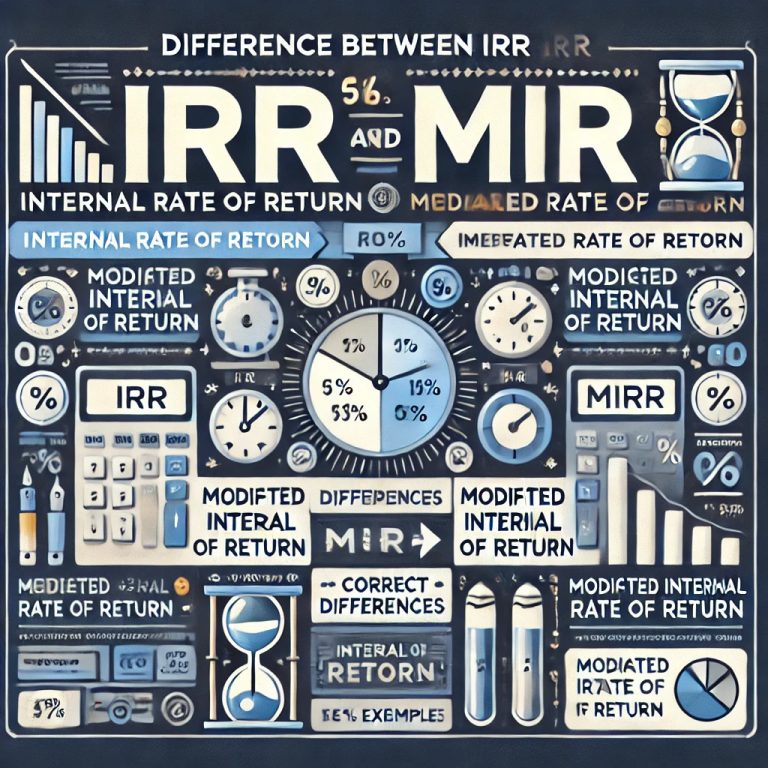The Difference Between IRR and MIRR is a critical concept in financial decision-making, especially when evaluating the profitability and efficiency of investments. While the Internal Rate of Return (IRR) measures the rate at which an investment breaks even, the Modified Internal Rate of Return (MIRR) provides a more accurate depiction by addressing IRR’s limitations, particularly with reinvestment assumptions. Understanding these metrics helps businesses and investors assess projects effectively and make informed financial decisions.
What is the Internal Rate of Return?
The Internal Rate of Return (IRR) is the discount rate at which the net present value (NPV) of all cash flows from an investment equals zero. It represents the break-even point of an investment and is widely used for project evaluation and capital budgeting.
Features of IRR
- Discount Rate: Indicates the rate at which project inflows match outflows.
- Decision Metric: A project is generally considered viable if the IRR exceeds the required rate of return.
- No Reinvestment Assumption: Assumes reinvestment at the IRR, which may not be realistic.
IRR in Practice:
Example: For an investment of $10,000 generating $3,000 annually for 5 years, the IRR is the rate making the NPV of cash flows zero.
What is the Modified Internal Rate of Return?
The Modified Internal Rate of Return (MIRR) refines the IRR by addressing its reinvestment assumption. MIRR assumes reinvestment at the project’s cost of capital or a more realistic rate, offering a better reflection of an investment’s potential.
- Reinvestment Rate: Assumes reinvestment at a predefined rate, often the cost of capital.
- Realistic Evaluation: Avoids the pitfalls of multiple IRRs in unconventional cash flows.
- Decision Metric: A project with MIRR exceeding the hurdle rate is considered favorable.
MIRR Formula:
IRR and MIRR Formula
MIRR Formula:
Comparison Table of Assumptions:
| Metric | IRR | MIRR |
| Reinvestment Rate | Assumes reinvestment at IRR | Assumes reinvestment at cost of capital or another rate. |
| Calculation | Iterative | Direct, using realistic rates. |
IRR and MIRR Differences
IRR (Internal Rate of Return) calculates the discount rate equating cash inflows and outflows, while MIRR (Modified Internal Rate of Return) adjusts for reinvestment and financing costs for more accurate profitability assessment.
| Aspect | IRR | MIRR |
| Reinvestment Assumption | Assumes reinvestment at IRR | Assumes reinvestment at cost of capital. |
| Handling Multiple IRRs | May produce multiple IRRs in unconventional cash flows. | Provides a single, definitive value. |
| Complexity | Requires iterative computation. | More straightforward and realistic. |
| Practical Application | Suited for traditional cash flows. | Ideal for modern and unconventional cash flows. |
IRR and MIRR Examples and Calculation
An investment of $10,000 generates cash flows of $3,000, $4,000, and $5,000 over three years. The cost of capital is 8%.
IRR Calculation:
– Solving iteratively, IRR = 14.49%.
– Assumes reinvestment at 14.49%, which might not align with market conditions.
MIRR Calculation:
Conclusion
The Difference Between IRR and MIRR is pivotal in choosing the right metric for investment appraisal. While IRR provides a general sense of a project’s profitability, its reinvestment assumptions and susceptibility to multiple solutions make it less reliable for complex scenarios. MIRR, on the other hand, offers a practical and accurate assessment, aligning with real-world reinvestment conditions. For businesses and investors, understanding these metrics ensures better decision-making and financial planning.
Difference Between IRR and MIRR FAQs
Why is MIRR considered more accurate than IRR?
MIRR assumes a realistic reinvestment rate, avoiding the overestimation of returns.
Can IRR and MIRR produce the same result?
Yes, in rare cases where reinvestment occurs exactly at the IRR, the two metrics align.
Which is better for evaluating unconventional cash flows?
MIRR is better as it avoids the issue of multiple IRRs.
How does MIRR handle reinvestment assumptions?
MIRR assumes reinvestment at the cost of capital or a predetermined rate.
Is IRR suitable for short-term projects?
Yes, but its assumptions may still lead to inaccuracies without careful consideration.


